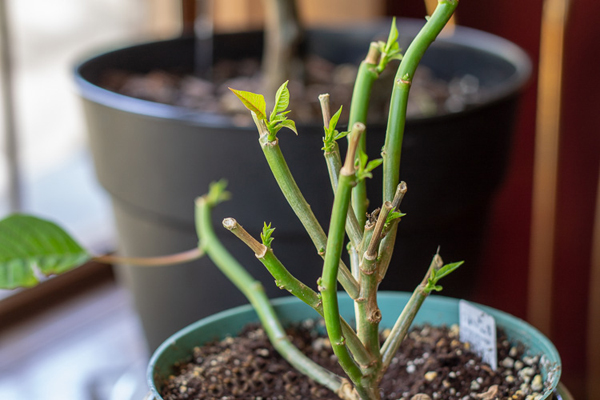
PIONSETTIA RE-BLOOMING

Getting poinsettias to re-bloom is not easy, but with some patience and care it can be done.
Late Winter – Early Spring
You will want to cut back each of the old flowering stems to 4 to 6 inches in height. Do this in March or April. This will promote new growth.
Late Spring – Summer
Repot into a pot 2-3” larger than the original. Be sure the soil is moistened and place in a sunny window. When all danger of frost has passed and night temperature is above 60°F the plant can be placed outdoors.
Place the poinsettia in a shady location for two to three weeks to allow it to become acclimated to the new environment. Then sink the pot in a sunny protected outdoor flowerbed. Turn the poinsettia pot regularly to prevent rooting through the bottom hole. It is suggested that a quarter turn each week will prevent this and will also help to keep the plant growth even all around the pot. If the pot is not turned, one side may get more sun than the other. Light shade during the afternoon is okay.
Keep the plant growing actively all summer by regular watering and feeding every two weeks with a complete water soluble fertilizer (20-20-20).
If you prefer a short plant with many flowers, pinch out the growing shoots to encourage branching. Pinching should produce more flowers and a nice bushy plant. This should be done at 3 to 4 week intervals, according to the speed of growth. Pinch out the top 1/4-inch by hand. Two or three large fully expanded leaves should be left below the pinch; this serves as a guide for knowing when the shoots are ready for pinching. Continue this practice until mid- August, when the plant should have a satisfactory shape and number of shoots.
Keep the plant growing actively all summer by regular watering and feeding every two weeks with a complete soluble fertilizer (20-20-20).
Fall
Before night temperatures fall below 55-60°F at night, bring the poinsettia indoors to a sunny location. Check for pests and diseases and place poinsettia in a south window.
Reduce the amount of fertilizer when the plant is brought indoors. The lower light intensity will reduce it’s need for food.
Flowering is “photo periodically” induced in the poinsettia. This means that flowers begin to form when the days are a certain length, or, more accurately, when the nights are long enough. The poinsettia is a short-day or long-night plant. Without long nights, this plant will continue to produce leaves and will grow but will never flower. You must make certain it receives no light from any source.
Very short periods of lighting at night may be enough to prevent or interfere with flowering. Even light from a streetlight can stop flowering. If the plant is to be grown in a room that is lighted nightly, cover it completely at dusk (5 p.m.) every day with a heavy paper bag, a piece of opaque black cloth, other light-tight cover or place in a dark closet.
Flower initiation begins in late September and early October. Dark periods longer than 12 hours are necessary for flower set. Flowers mature in from 60 to 85 days depending on varieties, temperature and light intensity.
Because flower initiation depends upon the length of the dark period, your poinsettia must be kept completely dark from5 p.m.to8 a.m.The time to give this treatment is from the end of September until the bracts show good color.
Once you can see the flowers developing in the growing plants, i. e., when the floral bracts start to show definite color, it is not as important to continue giving the dark period, though it is advisable to continue until the bracts are almost fully expanded.
Temperatures should be no less than 55°F at night, but not more than 70°F. During the day give the poinsettia as much sunlight as possible.
High night temperatures, coupled with low-light intensity, low nutrition, dry soil or improper photoperiod may delay maturity.

